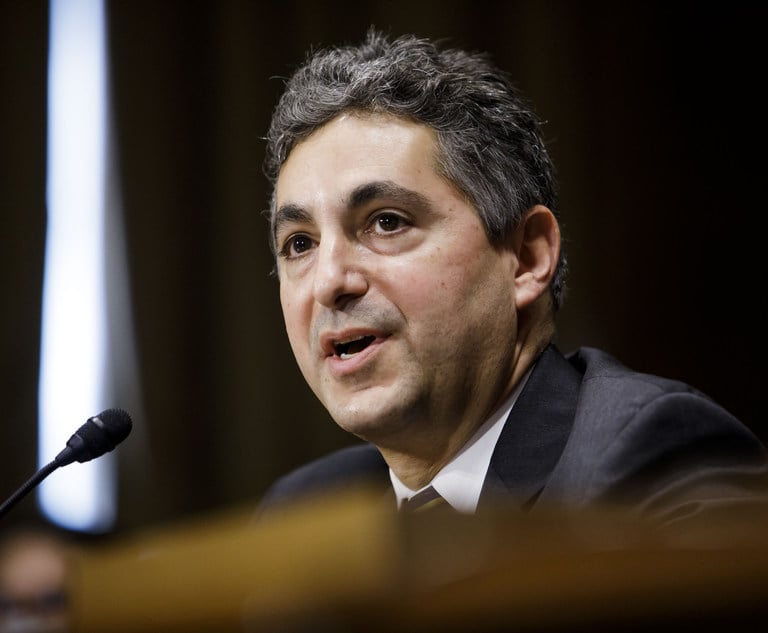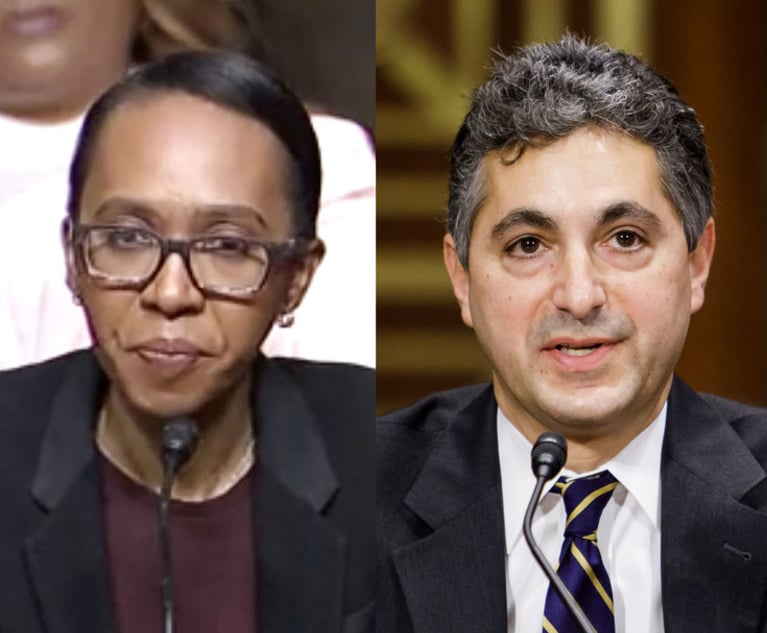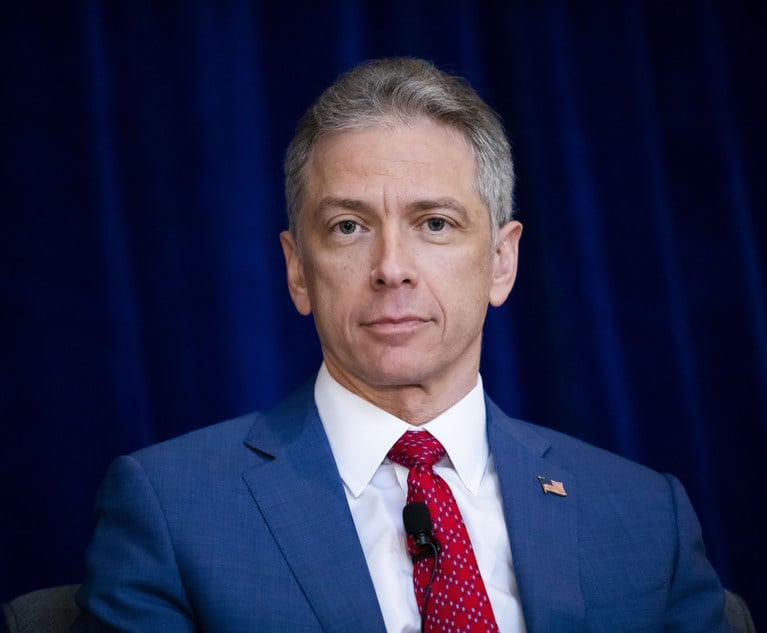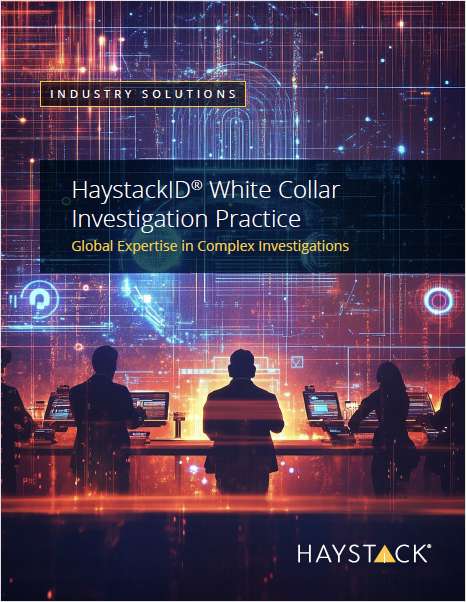Skilled in the Art:The Hearing That Could Cost Qualcomm Its Royalty Rates + Bringing Diagnostic Patent Wins Back to Life + How NPE Sausage Gets Made
If Qualcomm loses at the Ninth Circuit, it won't be the fault of liberal judges.
February 11, 2020 at 10:18 PM
9 minute read
Welcome to Skilled in the Art. I'm Law.com IP reporter Scott Graham. Here's what's cracking today:
• If Qualcomm loses at the Ninth Circuit, it won't be the fault of liberal judges.
• Stanford diagnostic patents beat the odds on patent eligibility.
• Burford Capital loses PTAB bid to knock out Cushing's Disease patent.
As always, you can email me your feedback and follow me on Twitter.
 Ninth Circuit Judges Consuelo Callahan, left, and Johnnie Rawlinson.
Ninth Circuit Judges Consuelo Callahan, left, and Johnnie Rawlinson.Qualcomm Again Draws Conservative 9th Circuit Panel
Qualcomm has had good luck so far in Ninth Circuit judicial draws in its dispute with the Federal Trade Commission. The three-judge panel that heard its motion for a stay pending appeal last summer? Two Republican appointees. The class certification appeal last fall? Three GOP appointees.
Now the panel that will hear the big kahuna—the merits appeal Thursday from U.S. District Judge Lucy Koh's bombshell antitrust ruling—has been chosen. Ninth Circuit Judges Consuelo Callahan and Johnnie Rawlinson plus visiting Judge Stephen Murphy III of the Eastern District of Michigan will decide whether Qualcomm must license its standard-essential patents to chipmaking rivals such as Intel, and stop threatening to disrupt modem chip supply when smartphone makers balk at Qualcomm's royalty rate.
Callahan and Murphy were appointed by President George W. Bush. Rawlinson was appointed by President Bill Clinton.
None has an obvious track record with high-stakes antitrust cases. It won't be Callahan's first patent case, though. She wrote Kimble v. Marvel Entertainment, which reaffirmed the rule that a patentee generally cannot contract for royalties to be paid after the expiration of a patent. The Supreme Court affirmed.
Murphy's background as an in-house litigator at General Motors before taking the bench in the early 2000s makes him an interesting wild card. Automotive industry trade groups and suppliers are among the amici curiae urging the court to affirm Koh's ruling that Qualcomm must license at the supplier level.
Arguing Thursday for Qualcomm will be Tom Goldstein of Goldstein & Russell. Qualcomm's primary argument is that it has no antitrust duty to deal with competitors such as Intel and MediaTek. Under the Supreme Court's Trinko and Aspen Skiing decisions, antitrust law trumps private competitive decisions only when a monopolist abandons profits, or if its only purpose is to damage competitors, Qualcomm argues in its appellate briefs. Neither situation applies in its dispute with the FTC, Qualcomm says.
Qualcomm did promise standard-setting organizations that it would make all of its standard-essential patents "available to all applicants" on fair, reasonable and non-discriminatory (FRAND) terms. Qualcomm argues "all applicants" means all smartphone makers that implement the technology, but Koh had pointed to Ninth Circuit case law that the FRAND commitment applies to "all comers." That encompasses chip suppliers, she ruled.
Deputy Attorney General Michael Murray of the antitrust division is expected to argue for the government that disrupting Qualcomm's licensing practices could harm the development of 5G technologies and compromise national security.
The FTC will be represented by Brian Fletcher, a former assistant to the solicitor general who is special counsel to the FTC. The agency argues that Aspen and Trinko don't apply when a monopolist "breaches its own voluntary commitments" to license patented technology used in industry-wide standards.
FTC further argues that Qualcomm doesn't present smartphone makers with patent lists, claim charts, or any other information that drives ordinary negotiations. "Instead, OEMs agree to pay Qualcomm's royalties only because Qualcomm threatens to cut off their chip supply if they do not," FTC argues.
 Weil Gotshal partner Ed Reines (Photo by Jason Doiy/ALM).
Weil Gotshal partner Ed Reines (Photo by Jason Doiy/ALM).Prognosis Improves for Diagnostic Patents
Medical diagnostics patents aren't dead yet. At least, not all of them.
Last year, the Federal Circuit and the solicitor general called on the Supreme Court to reconsider the application of Section 101 of the Patent Act to medical diagnostics. "Since Mayo, we have held every single diagnostic claim in every case before us ineligible," Judge Kimberly Moore wrote for herself and three other Federal Circuit judges in Athena Diagnostics v. Mayo Collaborative. The bottom line for diagnostics patents is problematic," Judge Todd Hughes wrote for himself and two others.
Of course, the Supreme Court declined to take up the case last month, and the outlook for diagnostics patents has remained dim.
But on Monday, Brisbane, California-based CareDx took a big step toward getting judicial approval of its patented AlloSure technology for assessing organ transplant rejections via a blood test.
U.S. Magistrate Judge Christopher Burke of Delaware recommended that two patents developed at Stanford University and licensed to CareDx be ruled eligible for patenting.
"We're delighted that the Stanford patents were upheld on Section 101 grounds given the current state of the law," said Weil, Gotshal & Manges partner Ed Reines, who represents CareDx and Stanford.
CareDx sued San Carlos, California-based Natera and Lee's Summit, Missouri-based Eurofins Viracor last year.
Natera, represented by Quinn Emanuel Urquhart & Sullivan, and Viracor, represented by Goodwin Procter, moved to dismiss. Natera argued last summer that the patents "rest entirely on observing natural phenomena inherent to organ transplants: the presence of an organ donor's nucleic acids (such as DNA) in the transplant recipient's circulation (such as blood), and a correlation of that presence to rejection of the transplanted organ by the recipient's body."
To Burke, what tipped the balance was language in the claim specification "repeatedly and consistently" saying that that correlation had already been well-known for a long time. "Thus, the patent explains, scientists had for years been attempting to find ways to test for and detect the presence of such donor-specific cfDNA," Burke wrote in an 11-page order.
What was invented was "a genetic fingerprint" of the organ donor that would show up in the recipient's blood if the organ were being rejected. Specifically, that would be "the use of digital PCR/high-throughput sequencing/multiplex sequencing, at certain levels of sensitivity, to identify homozygous or heterozygous [single nucleotide polymorphisms] in the blood of the transplant recipient," Burke wrote.
"It is these purportedly new, unconventional combination of steps that the claims are directed to, not the natural law itself," Burke concluded.
He even threw in a cf citation to the Federal Circuit's Athena opinion for good measure.
It will now be up to U.S. District Judge Colm Connolly whether to adopt Burke's recommendation.

Funder Loses Bid to Knock Out Pharma Patent
Ever wonder what it might look like if non-practicing entities were forced to publicly disclose their financial backing in litigation?
We got a taste this week in the IPR of Neptune Generics LLC v. Corcept Therapeutics Inc. Neptune Generics doesn't appear to manufacture or distribute generic drugs. Rather, it's a creation of litigation funder Burford Capital whose primary purpose appears to be bringing IPRs against branded pharma companies. It seems not unlike Kyle Bass' Coalition for Affordable Drugs a few years back.
But Burford is a publicly traded company and to its credit, Neptune was upfront with the PTAB about its corporate structure. Here's how it explained it:
Neptune Generics, LLC; Niagara FundingCo, LLC; GKC Partners II, LP; GKC General Partner II, LP; Burford Capital Ireland DAC; GKC PII Holdings, LLC; Burford Capital Investment Management LLC; Burford Capital Holdings (UK) Limited; and Burford Capital Limited are the real parties in interest (collectively, "RPI"). Neptune Generics, LLC, a New York limited liability company, is 100% owned by Niagara FundingCo, LLC, a New York limited liability company, which itself is 100% owned by GKC Partners II, LP, a Delaware limited partnership.
Neptune, represented by Massey & Gail was trying to invalidate a Corcept patent on a drug called Korlym. It's based on the medicine mifepristone, which historically is used to terminate pregnancies. At a blood serum level of 1300 nanograms per milliliter, mifepristone also helps alleviate Cushing's Disease, which is characterized by anxiety and severe weight gain.
Neptune argued that the patent merely sets an optimal dosage for treating Cushing's Disease, which would have been obvious for a POSA to find. Not so, argued Corcept's Latham & Watkins attorneys. The same dose of mifepristone can produce blood serum levels that vary by as much as 800% from individual to individual.
The patent discloses a more accurate method of measuring it, and directs that the dose be adjusted each day for seven days until reaching that 1300 ng/ml level to treat Cushing's, Latham argued.
The PTAB agreed in a final written decision issued Monday. "The testimony of Petitioner's own expert calls into question whether a POSA could indeed have optimized serum levels by adjusting dosing (and whether a POSA would have seen value in doing so)," Administrative Patent Judge David Cotta wrote for the PTAB.
Latham's team featured partners Bob Steinberg and David Frazier and associate Michelle Ernst.
|
IP Laterals—Dickinson Wright
Dickinson Wright has added six IP attorneys, including four partners, to its Ann Arbor, Michigan, office from Brinks Gilson & Lione. Jim Cleland, Linda Nattler, Steven Oberholtzer and Michael Spink join as partners; Keith Weiss joins as of counsel and Sung Lee as an associate.
"We are excited to welcome Jim, Linda, Steven, Michael, Keith, and Sung to the firm's intellectual property team," Philip Rettig, division director of Dickinson Wright's IP practice said. "The addition of these six extraordinary lawyers deepens the strength of Dickinson Wright's national intellectual property practice."
That's all from Skilled in the Art this week. I'll see you all again on Friday.
This content has been archived. It is available through our partners, LexisNexis® and Bloomberg Law.
To view this content, please continue to their sites.
Not a Lexis Subscriber?
Subscribe Now
Not a Bloomberg Law Subscriber?
Subscribe Now
NOT FOR REPRINT
© 2024 ALM Global, LLC, All Rights Reserved. Request academic re-use from www.copyright.com. All other uses, submit a request to [email protected]. For more information visit Asset & Logo Licensing.
You Might Like
View All
Skilled in the Art With Scott Graham: I'm So Glad We Had This Time Together

Design Patent Appeal Splinters Federal Circuit Panel + Susman Scores $163M Jury Verdict + Finnegan Protects Under Armour's House
Law Firms Mentioned
Trending Stories
- 1Gibson Dunn Sued By Crypto Client After Lateral Hire Causes Conflict of Interest
- 2Trump's Solicitor General Expected to 'Flip' Prelogar's Positions at Supreme Court
- 3Pharmacy Lawyers See Promise in NY Regulator's Curbs on PBM Industry
- 4Outgoing USPTO Director Kathi Vidal: ‘We All Want the Country to Be in a Better Place’
- 5Supreme Court Will Review Constitutionality Of FCC's Universal Service Fund
Who Got The Work
Michael G. Bongiorno, Andrew Scott Dulberg and Elizabeth E. Driscoll from Wilmer Cutler Pickering Hale and Dorr have stepped in to represent Symbotic Inc., an A.I.-enabled technology platform that focuses on increasing supply chain efficiency, and other defendants in a pending shareholder derivative lawsuit. The case, filed Oct. 2 in Massachusetts District Court by the Brown Law Firm on behalf of Stephen Austen, accuses certain officers and directors of misleading investors in regard to Symbotic's potential for margin growth by failing to disclose that the company was not equipped to timely deploy its systems or manage expenses through project delays. The case, assigned to U.S. District Judge Nathaniel M. Gorton, is 1:24-cv-12522, Austen v. Cohen et al.
Who Got The Work
Edmund Polubinski and Marie Killmond of Davis Polk & Wardwell have entered appearances for data platform software development company MongoDB and other defendants in a pending shareholder derivative lawsuit. The action, filed Oct. 7 in New York Southern District Court by the Brown Law Firm, accuses the company's directors and/or officers of falsely expressing confidence in the company’s restructuring of its sales incentive plan and downplaying the severity of decreases in its upfront commitments. The case is 1:24-cv-07594, Roy v. Ittycheria et al.
Who Got The Work
Amy O. Bruchs and Kurt F. Ellison of Michael Best & Friedrich have entered appearances for Epic Systems Corp. in a pending employment discrimination lawsuit. The suit was filed Sept. 7 in Wisconsin Western District Court by Levine Eisberner LLC and Siri & Glimstad on behalf of a project manager who claims that he was wrongfully terminated after applying for a religious exemption to the defendant's COVID-19 vaccine mandate. The case, assigned to U.S. Magistrate Judge Anita Marie Boor, is 3:24-cv-00630, Secker, Nathan v. Epic Systems Corporation.
Who Got The Work
David X. Sullivan, Thomas J. Finn and Gregory A. Hall from McCarter & English have entered appearances for Sunrun Installation Services in a pending civil rights lawsuit. The complaint was filed Sept. 4 in Connecticut District Court by attorney Robert M. Berke on behalf of former employee George Edward Steins, who was arrested and charged with employing an unregistered home improvement salesperson. The complaint alleges that had Sunrun informed the Connecticut Department of Consumer Protection that the plaintiff's employment had ended in 2017 and that he no longer held Sunrun's home improvement contractor license, he would not have been hit with charges, which were dismissed in May 2024. The case, assigned to U.S. District Judge Jeffrey A. Meyer, is 3:24-cv-01423, Steins v. Sunrun, Inc. et al.
Who Got The Work
Greenberg Traurig shareholder Joshua L. Raskin has entered an appearance for boohoo.com UK Ltd. in a pending patent infringement lawsuit. The suit, filed Sept. 3 in Texas Eastern District Court by Rozier Hardt McDonough on behalf of Alto Dynamics, asserts five patents related to an online shopping platform. The case, assigned to U.S. District Judge Rodney Gilstrap, is 2:24-cv-00719, Alto Dynamics, LLC v. boohoo.com UK Limited.
Featured Firms
Law Offices of Gary Martin Hays & Associates, P.C.
(470) 294-1674
Law Offices of Mark E. Salomone
(857) 444-6468
Smith & Hassler
(713) 739-1250










